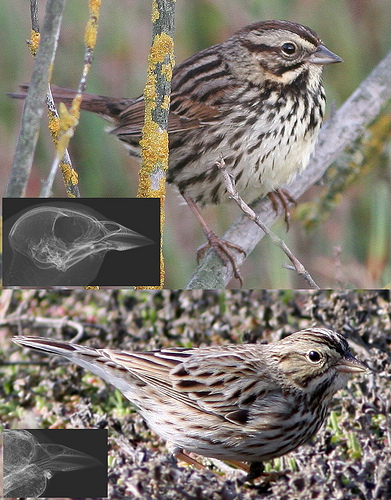X-Rays Indicate That Bill Size Matters in Sparrows' Quest for True Love
Are bird bills simply for eating or do they play a role in mating? Researchers from the Smithsonian Conservation Biology Institute sought to answer this question using digital X-rays to examine thousands of horny bills from its bird collection and specimen loans from other museums. The results published recently in Ecology and Evolution suggest that beaks grow during breeding season and help birds attract that special mate and beat other males in contests.
Traditionally, we've viewed bill size in terms of how it helps birds eat, said Russell Greenberg, head of SCBI's Migratory Bird Center and paper co-author. By looking at the infrastructure of bird bills using X-rays, we discovered that male bill sizes change seasonally, suggesting that bills play a role in mating and fighting as well. What's also interesting is that we combined technology and this expansive bird collection to conduct this first-of-a-kind study—which is helping us better understand why birds have different beak sizes and shapes.
Unlike the skeletal system, the horny bills are made of keratin, causing them to grow, wear and vary in size throughout a bird's life, much like fingernails and hair on humans. The horny covering of the bill functions much like the horns of cattle and goats and other animals where males have bigger horns than females.
For this study, two groups of tidal marsh sparrows were examined because their horny bills differ more in size between the sexes. The study found significant seasonal and sex-based variation in the bill size of the two sparrow subspecies. Bills are smallest in the late autumn and increase to their maximum size in the late spring to early summer, which is the breeding season for these species. Overall, males tend to have larger bills than females, and their bills grow proportionally more during the breeding season than females.
In addition to Greenberg, Smithsonian scientist Raymond M. Danner and Mathew Etterson of the U.S. Environmental Protection Agency also contributed to the paper, which they anticipate will lead to field studies that test how males use their larger bills during the breeding season.
These results follow recent related findings released last summer that compared two subspecies of song sparrows living in different habitats and found that bill size also varies according to climate. Sparrows living in hotter, drier conditions had larger bills, which gave them more surface area to lose heat, thus saving water. The study explains how bird bills act like radiators, keeping sparrows cool so that they do not get dehydrated. As this study shows, males could grow larger bills to stay cooler while they sing to attract mates and ward off rivals.
The Smithsonian Conservation Biology Institute plays a key role in the Smithsonian's global efforts to understand and conserve species and train future generations of conservationists. Headquartered in Front Royal, Va., SCBI facilitates and promotes research programs based at Front Royal, the National Zoo in Washington, D.C., and at field research stations and training sites worldwide.

